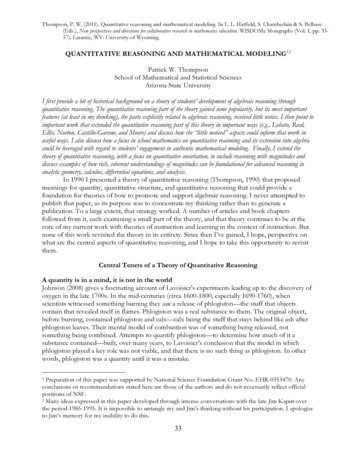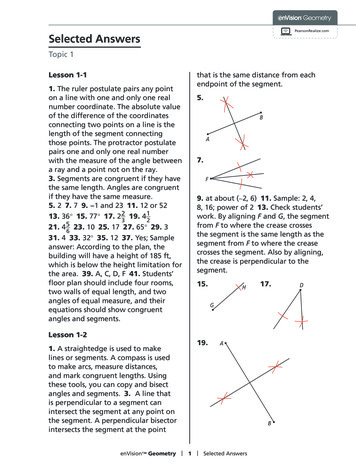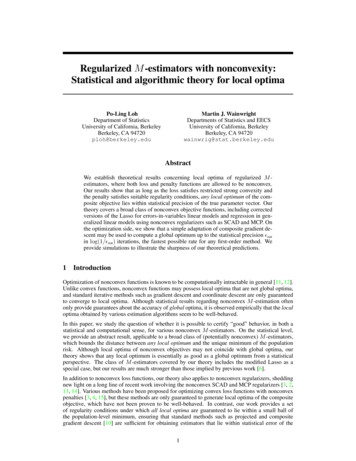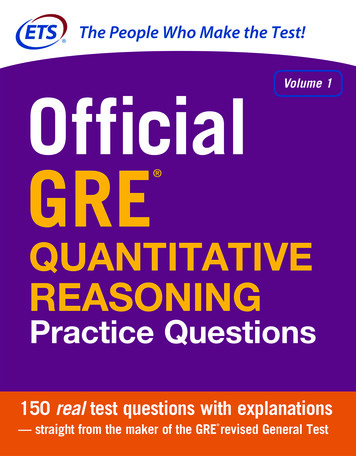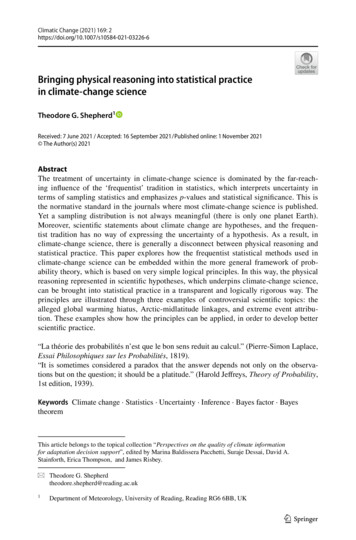
Transcription
Climatic Change (2021) 169: g physical reasoning into statistical practicein climate‑change scienceTheodore G. Shepherd1Received: 7 June 2021 / Accepted: 16 September 2021 /Published online: 1 November 2021 The Author(s) 2021AbstractThe treatment of uncertainty in climate-change science is dominated by the far-reaching influence of the ‘frequentist’ tradition in statistics, which interprets uncertainty interms of sampling statistics and emphasizes p-values and statistical significance. This isthe normative standard in the journals where most climate-change science is published.Yet a sampling distribution is not always meaningful (there is only one planet Earth).Moreover, scientific statements about climate change are hypotheses, and the frequentist tradition has no way of expressing the uncertainty of a hypothesis. As a result, inclimate-change science, there is generally a disconnect between physical reasoning andstatistical practice. This paper explores how the frequentist statistical methods used inclimate-change science can be embedded within the more general framework of probability theory, which is based on very simple logical principles. In this way, the physicalreasoning represented in scientific hypotheses, which underpins climate-change science,can be brought into statistical practice in a transparent and logically rigorous way. Theprinciples are illustrated through three examples of controversial scientific topics: thealleged global warming hiatus, Arctic-midlatitude linkages, and extreme event attribution. These examples show how the principles can be applied, in order to develop betterscientific practice.“La théorie des probabilités n’est que le bon sens reduit au calcul.” (Pierre-Simon Laplace,Essai Philosophiques sur les Probabilités, 1819).“It is sometimes considered a paradox that the answer depends not only on the observations but on the question; it should be a platitude.” (Harold Jeffreys, Theory of Probability,1st edition, 1939).Keywords Climate change · Statistics · Uncertainty · Inference · Bayes factor · BayestheoremThis article belongs to the topical collection “Perspectives on the quality of climate informationfor adaptation decision support”, edited by Marina Baldissera Pacchetti, Suraje Dessai, David A.Stainforth, Erica Thompson, and James Risbey.* Theodore G. Shepherdtheodore.shepherd@reading.ac.uk1Department of Meteorology, University of Reading, Reading RG6 6BB, UK13Vol.:(0123456789)
2 Page 2 of 19Climatic Change (2021) 169: 21 IntroductionAs climate change becomes increasingly evident, not only in global indicators but at thelocal scale and in extreme events, the challenge of developing climate information fordecision-making becomes more urgent. It is taken as given that such information shouldbe based on sound science. However, it is far from obvious what that means. As withmany other natural sciences, controlled experiments on the real climate system cannot beperformed, and climate change is by definition statistically non-stationary. Together thismeans that scientific hypotheses cannot be tested using traditional scientific methods suchas repeated experimentation. (Experiments can be performed on climate simulation models, but the models differ from the real world in important respects, and often disagree witheach other.) On the global scale, it is nevertheless possible to make scientific statementswith high confidence, and to speak of what can be considered to be effectively climatechange ‘facts’ (e.g. the anthropogenic greenhouse effect, the need to go to net-zero greenhouse gas emissions in order to stabilize climate), which are sufficient to justify action onmitigation. This is because the process of spatial aggregation tends to reduce the relevantphysical principles to energetic and thermodynamic ones which are anchored in fundamental theory (Shepherd 2019), and to beat down much of the climate noise so that the signalsof change emerge clearly in the observed record (Sippel et al. 2020).Yet for many aspects of climate-change science, there is no consensus on what constitutes fundamental theory, the signals of change are not unambiguously evident in theobserved record, and climate models provide conflicting results. This situation occurs withso-called climate ‘tipping points’, due to uncertainties in particular climate feedbacks (Lenton et al. 2008). It also occurs on the space and time scales relevant for climate adaptation,where atmospheric circulation strongly determines climatic conditions, yet there is verylittle confidence in its response to climate change (Shepherd 2014). These uncertaintiescompound in the adaptation domain, where human and natural systems play a key role(Wilby and Dessai 2010).This situation of ambiguous possible outcomes is illustrated by Fig. 1, which shows theprecipitation response to climate change across the CMIP5 climate models as presented byIPCC (2013). Stippling indicates where the multi-model mean change is large comparedto internal variability, and 90% of the models agree on the sign of change, whilst hatching indicates where the multi-model mean change is small compared to internal variability. These metrics embody the concept of ‘statistical significance’, which underpins theusual approach to uncertainty in climate-change science. Yet they are seen to be agnosticover many populated land regions, including most of the Global South, which are neitherhatched nor stippled. Zappa et al. (2021) have shown that in those regions, the models suggest precipitation responses that are potentially large but are non-robust (i.e. uncertain insign), and that the same situation holds with the CMIP6 models.It follows that if climate-change science is to be informative for decision-making, it mustbe able to adequately reflect the considerable uncertainty that can exist in the information.The traditional language of science is usually framed in terms of findings, which for climate change might be explanations of past behaviour (attribution), or predictions of futurebehaviour (known as ‘projections’ when made conditional on the future climate forcing).To give just one example, the title of Sippel et al. (2020) is “Climate change now detectable from any single day of weather at global scale”. In the peer-reviewed literature, thesefindings are generally presented in a definitive, unconditional manner (op. cit., where it isindeed justified); some journals even insist that the titles of their articles are worded that13
Climatic Change (2021) 169: 2Page 3 of 19 2Fig. 1 Projected changes in precipitation (in %) over the twenty-first century from the CMIP5 models undera high climate forcing scenario (RCP8.5). Stippling indicates where the multi-model mean change is largecompared with natural internal variability in 20-year means (greater than two standard deviations) andwhere at least 90% of models agree on the sign of change. Hatching indicates where the multi-model meanchange is small compared with internal variability (less than one standard deviation). From the Summaryfor Policymakers of IPCC (2013)way. Caveats on the findings are invariably provided, but it is not straightforward to convertthose to levels of confidence in the finding. When made quantitative, the uncertainties arerepresented through some kind of error bar, usually around a best estimate. As Stirling(2010) has argued, such ‘singular, definitive’ representations of knowledge are inappropriate and potentially highly misleading when the state of knowledge is better described as‘plural, conditional’, as for mean precipitation changes in the unmarked regions in Fig. 1.There are many methods available for dealing with ‘plural, conditional’ knowledge withina decision framework (Weaver et al. 2013; Rosner et al. 2014), so there is certainly norequirement for climate information to be expressed in a ‘singular, definitive’ manner inorder to be useable.There are many reasons for this situation, some of which are non-scientific (e.g. thereward system, both for authors and for journals). My goal here is to focus on one of thescientific reasons, namely the statistical practice that characterizes most climate-changescience, which is still dominated by procedures that originate from the so-called ‘frequentist’ tradition in statistics. This tradition interprets uncertainty in terms of sampling statistics of a hypothetical population, and places a strong emphasis on p-values and statisticalsignificance. It does not provide a language for expressing the probability of a hypothesisbeing true, nor does it provide a home for the concept of causality. Yet scientific reasoning is about hypotheses (including the ‘findings’ mentioned earlier), and reasoning underuncertainty is simply a form of extended logic, generalizing the true/false dichotomy ofAristotelian logic to situations where a hypothesis has a probability of being true that lies13
2 Page 4 of 19Climatic Change (2021) 169: 2between 0 and 1 (Jeffreys 1961; Jaynes 2003). Moreover, the concept of causality is centralto physical science, as well as to decision-making since otherwise there is no connectionbetween decisions and consequences, and causality has a logical formulation as well (Pearland Mackenzie 2018; Fenton and Neil 2019). Those elements of physical reasoning arepart of scientific practice in climate-change science, but are not connected to statisticalpractice in an explicit way. Thus, it seems crucial to bring these elements into the treatmentof uncertainty.In lay terms, probability is the extent to which something is likely to happen or to be thecase. This includes frequency-based (or long-run) probabilities — the frequentist paradigm— as a special case, but it applies to single-outcome situations as well, such as a scientific hypothesis concerning climate change, where probability is interpreted as degree ofbelief. (For scientists, the word “belief” may cause some discomfort, but we can interpretbelief as expert judgement, which is a widely accepted concept in climate-change science,including by the IPCC (Mastrandrea et al. 2011).) The two concepts of uncertainty arequite distinct, yet are commonly confused, even by practicing climate scientists. Even theuse of frequency-based probabilities requires a degree of belief that they may be appropriately used for the purpose at hand, which is a highly non-trivial point when one is makingstatements about the real world. Jeffreys (1961) and Jaynes (2003) both argue that whilstthe frequentist methods generally produce acceptable outcomes in the situations for whichthey were developed (e.g. agricultural trials, quality control in industry), which are characterized by an abundance of data and little in the way of prior knowledge, they are notfounded in rigorous principles of probability (the ‘extended logic’ mentioned above, whichis so founded (e.g. Cox 1946)), and are not appropriate for the opposite situation of anabundance of prior knowledge and little in the way of data. For climate-change science,especially (although not exclusively) in the adaptation context, we are arguably in the latter situation: we have extensive physical knowledge of the workings of the climate systemand of the mechanisms involved in climate impacts, and very little data that measures whatwe are actually trying to predict, let alone under controlled conditions. This motivates areappraisal of the practice of statistics in climate-change science. In this I draw particularlyheavily on Jeffreys (1961), since he was a geophysicist and thus was grappling with scientific problems that have some commonality with our own.This paper is aimed at climate scientists. Its goal is to convince them that the frequentiststatistical methods that are standard in climate-change science should be embedded withina broader logical framework that can connect physical reasoning to statistical practice ina transparent way. Not only can this help avoid logical errors, it also provides a scientificlanguage for representing physical knowledge even under conditions of deep uncertainty,thereby expanding the set of available scientific tools. In this respect, making explicit andsalient the conditionality of any scientific statement is a crucial benefit, especially for adaptation where a variety of societal values come into play (Hulme et al. 2011). Note that I amnot arguing for the wholesale adoption of Bayesian statistical methods, although these mayhave their place for particular problems (see further discussion in Sect. 4). Rather, I amsimply arguing that we should follow Laplace’s dictum and embed our statistical calculations in common sense, so as to combine them with physical reasoning. Section 2 starts byreprising the pitfalls of ‘null hypothesis significance testing’ (NHST); although the pitfallshave been repeatedly pointed out, NHST continues to be widespread in climate-change science, and its dichotomous misinterpretation reinforces the ‘singular, definitive’ representation of knowledge. Section 2 goes on to discuss how the concept of frequency fits withinthe broader concepts of probability and inference. Section 3 examines a spectrum of casestudies: the alleged global warming hiatus, Arctic-midlatitude linkages, and extreme event13
Climatic Change (2021) 169: 2Page 5 of 19 2attribution. Together these illustrate how the principles discussed in Sect. 2 can be applied,in order to improve statistical practice. The paper concludes with a discussion in Sect. 4.2 Back to basicsThe ubiquitous use of NHST has been widely criticized in the published literature (e.g.Amrhein et al. 2019). To quote from the abstract of the psychologist Gerd Gigerenzer’sprovocatively titled paper ‘Mindless statistics’ (2004):Statistical rituals largely eliminate statistical thinking in the social sciences. Ritualsare indispensable for identification with social groups, but they should be the subjectrather than the procedure of science. What I call the ‘null ritual’ consists of threesteps: (1) set up a statistical null hypothesis, but do not specify your own hypothesisnor any alternative hypothesis, (2) use the 5% significance level for rejecting the nulland accepting your hypothesis, and (3) always perform this procedure.Gigerenzer refers to the social sciences, but is it actually any different in climate science1? Nicholls (2000) and Ambaum (2010) both provide detailed assessments showingthe widespread use of NHST in climate publications. This practice does not appear to havedeclined since the publication of those papers; indeed, my impression is that it has onlyincreased, exacerbated by the growing dominance of the so-called ‘high-impact’ journals which enforce the statistical rituals with particular vigour, supposedly in an effort toachieve a high level of scientific rigour. Ambaum (2010) suggests that the practice mayhave been facilitated by the ready availability of online packages that offer significancetests as a ‘black box’ exercise, even though no serious statistician would argue that thepractice of statistics should become a ‘black box’ exercise. I would add that Gigerenzer’sinsightful comment about “identification with social groups” may also apply to climatescientists, in that statistical rituals become a working paradigm for certain journals andreviewers. I suspect I am not alone in admitting that most of the statistical tests in my ownpapers are performed in order to satisfy these rituals, rather than as part of the scientificdiscovery process itself.Gigerenzer (2004) shows that NHST, as described above, is a bastardized hybrid of Fischer’s null hypothesis testing and Neyman–Pearson decision theory, and has no basis evenin orthodox frequentist statistics. According to Fischer, a null hypothesis test should onlybe performed in the absence of any prior knowledge, and before one has even looked atthe data, neither of which applies to the typical applications in climate science. Violationof these conditions leads to the problem known as ‘multiple testing’. Moreover, failure toreject the null hypothesis does not prove the null hypothesis, nor does rejection of the nullhypothesis prove an alternative hypothesis. Yet, these inferences are routinely made in climate science, and the oxymoronic phrase “statistically significant trend” is commonplace.Amrhein et al. (2019) argue that the main problem lies in the dichotomous interpretation of the result of a NHST — i.e. as the hypothesis being either true or falsedepending on the p-value — and they argue that the concept of statistical significanceshould be dropped entirely. (Their comment gathered more than 800 signatories from1I sometimes use the term “climate science”, because the points I make are applicable to climate sciencein general, but use “climate-change science” when I wish to emphasize that particular aspect of climate science.13
2 Page 6 of 19Climatic Change (2021) 169: 2researchers with statistical expertise.) Instead, they argue that all values of a samplingstatistic that are compatible with the data should be considered as plausible; in particular, two studies are not necessarily inconsistent simply because one found a statisticallysignificant effect and the other did not (which, again, is a common misinterpretation inclimate science). This aligns with Stirling’s (2010) warning, mentioned earlier, against‘singular, definitive’ representations of knowledge when the reality is more complex,and all I can do in this respect is urge climate scientists to become aware of the sweeping revolution against NHST in other areas of science. Instead, I wish to focus here onbringing physical reasoning into statistical practice, which is of particular relevance toclimate-change science for the reasons discussed earlier.Misinterpretation of NHST is rooted in the so-called ‘prosecutor’s fallacy’, which isthe transposition of the conditional. The p-value quantifies the probability of observing the data D under the null hypothesis H that the apparent effect occurred by chance.This is written P(D H), sometimes called the likelihood function, and is a frequentistcalculation based on a specified probability model for the null hypothesis, which couldbe either theoretical or empirical. (As noted earlier, the specification of an appropriate probability model is itself a scientific hypothesis, but let us set that matter aside forthe time being.) However, one is actually interested in the probability that the apparenteffect occurred by chance, which is P(H D). The two quantities are not the same, but arerelated by Bayes’ theorem:P(H D) P(H)P(D H).P(D)(1)To illustrate the issue, consider the case where H is not the null hypothesis but is ratherthe hypothesis that one has a rare illness, having tested positive for the illness (data D).Even if the detection power of the test is perfect, i.e. P(D H) 1, a positive test result maynevertheless indicate only a small probability of having the illness, i.e. P(H D) being verysmall, if the illness is sufficiently rare and there is a non-negligible false alarm rate, suchthat P(H) P(D). This shows the error that can be incurred from the transposition of theconditional if one does not take proper account of prior probabilities. In psychology, it isknown as ‘base rate neglect’ (Gigerenzer and Hoffrage 1995).The example considered above of the medical test is expressed entirely in frequentistlanguage, because the probability of the test subject having the illness (given no otherinformation, and before taking the test), P(H), is equated to the base rate of the illnesswithin the general population, which is a frequency. However, this interpretation is notapplicable to scientific hypotheses, for which the concept of a ‘long run’ frequency is nonsensical. To consider this situation, we return to the case of H being the null hypothesisand write Bayes’ theorem instead asP(H D) P(D H)P(H).P(D)(2)Equation (2) is mathematically equivalent to Eq. (1) but has a different interpretation.Now the probability of the apparent effect having occurred by chance, P(H D), is seento be the prior probability of there being no real effect, P(H), multiplied by the factorP(D H) P(D). The use of Bayes’ theorem in this way is often criticized for being sensitiveto the prior P(H). However, expert (prior) knowledge is also used in the formulation (1)to determine how to control for confounding factors and for other aspects of the statisticalanalysis, and it is widely used in climate-change science to determine how much weight to13
Page 7 of 19 2Climatic Change (2021) 169: 2place on different pieces of evidence. It is thus a strength, rather than a weakness, of Bayes’theorem that it makes this aspect of the physical reasoning explicit.The factor P(D H) P(D) in Eq. (2) represents the power of the data for adjusting one’sbelief in the null hypothesis. But whilst P(D H) is the p-value, we have another factor,P(D); how to determine it? This can only be done by considering the alternative hypotheses that could also account for the data D. We write H as the complement of H , so thatP( H) 1 P(H). (In practice, H should be enumerated over all the plausible alternativehypotheses.) From the fundamental rules of probability,(3)P(D) P(D H)P(H) P(D H)P( H),which can be substituted into Eq. (2). Thus, we can eliminate P(D), but only at the costof having to determine P(D H). In that case, it is simpler to divide Eq. (2) by the sameexpression with H replaced by H , which eliminates P(D) and yields the ‘odds’ version ofBayes’ theorem:P(D H) P(H)P(H D) .P( H D) P(D H) P( H)(4)This states that the odds on the data occurring by chance — the left-hand side of Eq. (4)— equal the prior odds of the null hypothesis multiplied by the first term on the right-handside of Eq. (4), which is known as the Bayes factor (Kass and Raftery 1995) and was heavily used by Jeffreys (1961). The deviation of the Bayes factor from unity represents thepower of the data for discriminating between the null hypothesis and its complement. (Notethat Eq. (4) holds for any two hypotheses, but its interpretation is simpler when the twohypotheses are mutually exclusive and exhaustive, as here.) One of the attractive featuresof the Bayes factor is that it does not depend on the prior odds, and is amenable to frequentist calculation when the alternative hypothesis can be precisely specified.The formulation (4) represents in a clear way the aphorism that ‘strong claims requirestrong evidence’: if the prior odds of the null hypothesis are very high, then it requires avery small Bayes factor to reject the null hypothesis. But Eq. (4) makes equally clear thatthe power of the data is represented not in the p-value P(D H) but rather in the Bayes factor, and that failure to consider the Bayes factor is a serious error in inference. To quoteJeffreys (1961, p. 58):We get no evidence for a hypothesis by merely working out its consequences andshowing that they agree with some observations, because it may happen that a widerange of other hypotheses would agree with those observations equally well. To getevidence for it we must also examine its various contradictories and show that theydo not fit the observations.Thus, for both reasons, the p-value P(D H) on its own is useless for inferring the probability of the effect occurring by chance, and thus for rejecting the null hypothesis, eventhough this is standard practice in climate science. Rather, we need to consider both theprior odds of the null hypothesis, and the p-value for the alternative hypothesis, P(D H).We will discuss the implications of this in more detail in Sect. 3 in the context of specificclimate-science examples. Here, we continue with general considerations. With regard tothe difference between the p-value P(D H) and the Bayes factor, Bayesian statisticians haveways of estimating P(D H) in general, and the outcome is quite shocking. Nuzzo (2014),for example, estimates that a p-value of 0.05 generally corresponds to a Bayes factor ofonly 0.4 or so, almost 10 times larger. The reason why the p-value can differ so much13
2 Page 8 of 19Climatic Change (2021) 169: 2from the Bayes factor is because the latter penalizes imprecise alternative hypotheses,which are prone to overfitting. The difference between the two is called the ‘Ockham factor’ by Jaynes (2003, Chapter 20), in acknowledgement of Ockham’s razor in favour of parsimony: “The onus of proof is always on the advocate of the more complicated hypothesis”(Jeffreys 1961, p. 343). The fact that such a well-established principle of logic is absentfrom frequentist statistics is already telling us that the latter is an incomplete language fordescribing uncertainty.It follows that in order for a p-value of 0.05 to imply a 5% likelihood of a false alarm(i.e. no real effect) — which is the common misinterpretation — the alternative hypothesismust already be a good bet. For example, Nuzzo (2014) estimates a 4% likelihood of a falsealarm when P(H) 0.1, i.e. the null hypothesis is already considered to be highly improbable. For a toss-up with P(H) 0.5, the likelihood of a false alarm given a p-value of 0.05rises to nearly 30%, and it rises to almost 90% for a long-shot alternative hypothesis withP(H) 0.95. Yet despite this enormous sensitivity of the inferential power of a p-value tothe prior odds of the null hypothesis, nowhere in any climate science publication have Iever seen a discussion of prior odds (or probabilities) entering the statistical interpretationof a p-value.In fact, in much published climate science, the alternative hypothesis to the null isalready a good bet, having been given plausibility by previous research or by physical arguments advanced within the study itself. In other words, the statistical analysis is only confirmatory, and the p-value calculation performed merely as a sanity check. However, it isimportant to understand the prior knowledge and assumptions that go into this inference.For transparency, they should be made explicit, and a small p-value should in no way beregarded as a ‘proof’ of the result.There is an exception to the above, when the data does strongly decide between the twohypotheses. This occurs in the case of detection and attribution of anthropogenic globalwarming, where the observed warming over the instrumental record can be shown to beinconsistent with natural factors, and fully explainable by anthropogenic forcing (e.g.IPCC 2013). In that case, the Bayes factor is very small, and a strong inference is obtainedwithout strong prior assumptions (mainly that all potential explanatory factors have beenconsidered). However, this ‘single, definitive’ situation is generally restricted to thermodynamic aspects of climate change on sufficiently coarse spatial and temporal scales (Shepherd 2014).A similar issue arises with confidence intervals. The frequentist confidence intervalrepresents the probability distribution of a sampling statistic of a population parameter.However, it does not represent the likely range of the population parameter, known as the‘credible interval’ (Spiegelhalter 2018). To equate the two, as is commonly done in climatescience publications, is to commit the error of the transposed conditional. In particular, itis common to assess whether the confidence interval around a parameter estimate excludesthe null hypothesis value for that parameter, as a basis for rejecting the null hypothesis.This too is an inferential error. However, the confidence interval can approximately correspond to the credible interval if a wide range of prior values are considered equally likely(Fenton and Neil 2019, Chap. 12), which is effectively assuming that the null hypothesisvalue (which is only one such value) is highly unlikely. Thus, once again, provided we areprepared to acknowledge that we are assuming the null hypothesis to be highly unlikely, theuse of a frequentist confidence interval may be acceptable.There is one more general point that is worth raising here before we go on to the examples. In most climate science, the use of ‘statistical rituals’ means that particular statistical metrics (such as the p-value) are used without question. However, statisticians well13
Climatic Change (2021) 169: 2Page 9 of 19 2Fig. 2 NASA GISTEMP time series of estimated observed annual global mean surface air temperatureexpressed as anomalies relative to the 1951–1980 reference period. The red line is a smoothed version ofthe time series. The grey band (added here) indicates the time period 1998–2012, which was defined as thehiatus period in Box TS.3 of IPCC (2013). From https:// data. giss. nasa. gov/ giste mp/, downloaded 31 May2021appreciate that every statistical metric involves a trade-off, and that the choice will dependon the decision context. For example, in forecasts, there is a trade-off between discrimination and reliability, and in parameter estimation, there is a trade-off between efficiency andbias. There is no objective basis for how to make those trade-offs. Part of better statisticalpractice in climate-change science is to recognize these trade-offs and acknowledge themin the presentation of the results.3 Examples3.1 The alleged global warming hiatusThe alleged global warming ‘hiatus’ was the apparent slowdown in global-mean warmingin the early part of the twenty-first century. Looking at it now (Fig. 2), it is hard to see whyit attracted so much attention. Yet it was the focus of much media interest, and a majorchallenge for the IPCC during the completion of the AR5 WGI report, in 2013. There aregood scientific reasons to try to understand the mechanisms behind natural variability inclimate, and there was also a question at the time of whether the climate models were overestimating the warming response to greenhouse gases. However, the media attention (andthe challenge for the IPCC) was mostly focused on whether climate change had wea
statistical practice. This paper explores how the frequentist statistical methods used in climate-change science can be embedded within the more general framework of prob-ability theory, which is based on very simple logical principles. In this way, the physical reasoning represented in sci

